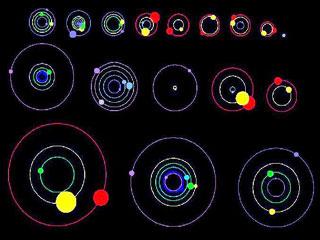
The image shows an overhead view of orbital positions of the planets in systems with multiple transiting planets discovered by NASA's Kepler mission. Photo: NASA.
WASHINGTON (BNS): NASA's Kepler mission has discovered 26 new planets outside our solar system, US space agency said on Thursday.
According to NASA, the new planets which are spread among 11 planetary systems are nearly double the number of verified Kepler planets and triple the number of stars known to have more than one planet that transits, or passes in front of, its host star.
The planets orbit close to their host stars and range in size from 1.5 times the radius of Earth to larger than Jupiter. Fifteen of them are between Earth and Neptune in size, and further observations will be required to determine which are rocky like Earth and which have thick gaseous atmospheres like Neptune.
"Prior to the Kepler mission, we knew of perhaps 500 exoplanets across the whole sky," Doug Hudgins, Kepler programme scientist at NASA Headquarters in Washington, said.
"Now, in just two years staring at a patch of sky not much bigger than your fist, Kepler has discovered more than 60 planets and more than 2,300 planet candidates. This tells us that our galaxy is positively loaded with planets of all sizes and orbits."
Each of the new confirmed planetary systems contains two to five closely spaced transiting planets. In tightly packed planetary systems, the gravitational pull of the planets among themselves causes one planet to accelerate and another planet to decelerate along its orbit. Kepler detects this effect by measuring the changes, or so-called Transit Timing Variations (TTVs).
The system with the most planets among these discoveries is Kepler-33, a star that is older and more massive than our sun. Kepler-33 hosts five planets, ranging in size from 1.5 to 5 times that of Earth and all located closer to their star than any planet is to the sun.
Kepler is monitoring more than 150,000 stars in the constellations Cygnus and Lyra.
 Previous Article
Previous Article Next Article
Next Article













The Indian Air Force, in its flight trials evaluation report submitted before the Defence Ministry l..
view articleAn insight into the Medium Multi-Role Combat Aircraft competition...
view articleSky enthusiasts can now spot the International Space Station (ISS) commanded by Indian-American astr..
view article